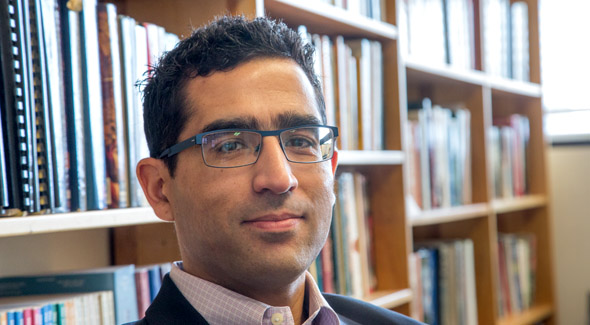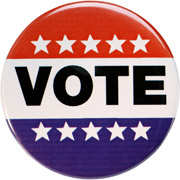ELECTION INSIGHTS 2016
Research-based perspectives from MIT
On Criminal Justice Reform | Malick Ghachem
Associate Professor of History

"Criminal law is no longer (if it ever was) only about 'criminals,' or even about 'crime.' It has become a matter of everyday life for far too many people."
— Malick Ghachem, Associate Professor of History
ELECTION INSIGHTS 2016
Research-based perspectives from MIT
Question
The need for reform in the U.S. criminal justice system has been a major issue for many during the 2016 presidential election. Based on your longstanding expertise and research as a lawyer and an historian of criminal law, what is the most important finding or perspective about criminal justice reform that would be useful for an American voter to know? And, if you could make one recommendation for better criminal justice policy in the United States, what would it be?
•
In modern American history, high-profile national and state elections have done much to set back the cause of a more egalitarian criminal justice system. From the 1960s through the 1990s, politicians of both major parties based key presidential and gubernatorial campaigns on a “law and order” platform that appealed to white fears of black criminality. Mass incarceration is partly the product of these campaigns, which span the gamut from George Wallace and Ronald Reagan to Lyndon Johnson and Bill Clinton. In 2016, “law and order” is once again the mantra of the Republican Party’s standard bearer — this time against the backdrop of resurgent white nationalism, growing public awareness of the problem of police violence against African-Americans, and the attendant rise of the “Black Lives Matter” (BLM) movement.
Local realities
Surveying this modern history, it would not be entirely facetious to suggest that the best way to avoid further damage to our many criminal justice systems is to avoid presidential elections altogether. But in criminal law, the key decisions are made at the state and local levels (which means the key electoral choices involve down-ballot races, including the county-level contests in which most district attorneys are chosen). Only 7 percent of felony prosecutions in the United States are federal cases.
Although some critics of our current direction have argued persuasively for more bureaucratic (i.e., non-popular) control of crime policy — along the line of many continental European nations — the available options are better vs. worse forms of local democracy, as the late William Stuntz argued in The Collapse of American Criminal Justice.
These local realities are typically obscured by all of the media attention accorded the high-profile presidential nominating battles, which often unfold as if neither the separation of powers nor federalism imposed meaningful constraints on what a president can do. Meanwhile, the current election season seems to have obscured another reality: While many minority voters are deeply concerned about criminal justice issues, they are also invested in the direction of education, housing, employment, foreign, and other policies.
And therein lies an important point about criminal justice reform itself: Inequalities in the distribution of both crime and punishment are likely to persist as long as inequalities in these other spheres of life continue to be seen as acceptable or inevitable costs of the free-market system. In the matter of crime and punishment, we have to be able to attend to these multiple dimensions of the problem simultaneously, with one eye on the prevention of further violence at the intersection of race and law enforcement, and another on the state of the schools and the availability of good jobs and homes in America’s urban centers.

"[W]hile many minority voters are deeply concerned about criminal justice issues, they are also invested in the direction of education, housing, employment, foreign, and other policies. And therein lies an important point about criminal justice reform itself: Inequalities in the distribution of both crime and punishment are likely to persist as long as inequalities in these other spheres of life continue to be seen as acceptable or inevitable costs of the free-market system."
A matter of everyday life
The sheer scale of these structural challenges can itself appear as an impediment to reform. But a problem that is deeply rooted in history does not, for that reason, have to remain immune to reform. BLM is a case in point: Official and private violence against African-Americans has a long history in the United States, yet the BLM movement has effectively focused national attention on a very specific, remediable issue. On this issue, more and better education is the only way forward.
More effective training of law enforcement officers in the prevention of conflicts, and in the de-escalation of conflicts once they have arisen, is essential. But police officers can also themselves serve as educators of the community: custodians of shared environments of the kind that Frederick Law Olmsted envisioned for New York’s Central Park in the 1870s, rather than quasi-military actors focused on suppressing clear-cut threats to life and property (as David Thacher shows in "Olmstead's Police," an important 2015 article in Law and History Review). This approach informs the recent rise of community policing, whose ultimate potential depends, in part, on whether the Supreme Court is willing to adopt a different interpretation to the Second Amendment in coming years.
Finally, the training of the next generation of lawyers at many law schools remains committed to an older model of what criminal justice entails. First-year students continue to focus exclusively on the so-called “substantive” criminal law: the definition of crimes, the burdens of proof, etc. By contrast, the regulation of policing — the law of the Fourth, Fifth, and Sixth amendments, or what we call “criminal procedure” — remains a subject for advanced study, to be pursued only by students with a defined interest in criminal law. That should change in light of BLM: Criminal law is no longer (if it ever was) only about “criminals,” or even about “crime.” It has become a matter of everyday life for far too many people.
Suggested links
ELECTION INSIGHTS 2016
Research-based perspectives from MIT
Malick Ghachem's webpage
MIT History Section
Race, Crime, and Citizenship in American Law (21H.319)
Ghachem course on OpenCourseWare
The Old Regime and the Haitian Revolution
by Malick Ghachem (Cambridge University Press, 2012)
How to Vote in Every State
See video with info for your state — and vote!
Series prepared by MIT SHASS Communications
Photograph of Malick Ghachem by Jon Sachs
